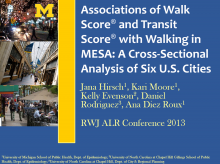We are pleased to announce an exciting new alliance between Active Living Research and GP RED to co-host and coordinate...
Associations of Walk Score and Transit Score with Walking in MESA: A Cross-Sectional Analysis of Six U.S. Cities

Presentation at the 2013 Active Living Research Annual Conference.
View the research paper and YouTube Videocast of the manuscript.
Background and Purpose: Most objective measures of the built environment require the use of Geographic Information Systems (GIS). However, knowing how to obtain, clean, manage, and analyze GIS-based data requires trained personnel and sufficient time to conduct these activities. Walk Score® is a measure of “walkability” created by Front Seat Management, LLC that combines distance to destinations (i.e. grocery, restaurants, shopping, banks, parks, schools, entertainment) and is weighted based on pedestrian-friendly street characteristics (intersection density, block length). Transit Score® is a new product by Front Seat Management, available in some cities, that measures access to various forms of public transportation. Since scores are open-source and available to the public, they may be useful in translating built environment research into practical application and policy. Limited research has explored the links between Walk Score® and walking behaviors.
Objectives: Examine associations of Walk Score® and Transit Score® with walking in a multi-ethnic and geographically diverse adult population.
Methods: Street Smart Walk Score® and Transit Score® were purchased for 4552 participants in the Multi-Ethnic Study of Atherosclerosis (MESA) from all six study sites (CA, IL, MD, MN, NC, NY). MESA is a longitudinal cohort study of participants free of clinically apparent heart disease, started in 2000. Walking was assessed by questionnaire and examined as a continuous (minutes per week) and categorical variable (walking vs. not walking during a typical week). Two types of walking, transport (to get from one place to another) and leisure (for exercise, or enjoyment), were assessed. Linear and logistic regression models were used to estimate associations of Walk Score® and Transit Score® with walking, after adjustment for potential confounders. Street Smart Walk Score® and Transit Score® were assessed both in 10-unit increments (continuous) and by the categories suggested on the Street Smart Walk Score® website (0-24 very car dependent/minimal transit, 25-49 car dependent/some transit, 50-69 somewhat walkable/good transit, 70-89 very walkable/excellent transit, 90-100 walker’s/rider’s paradise). Within neighborhood correlation was accounted for using marginal models.
Results: Mean and Standard Deviation of Street Smart Walk Score® and Transit Score® in the sample were 54.1 (32.4) and 69.0 (23.4) respectively. Adjusting for confounders, a 10-unit increase in Street Smart Walk Score® was associated with an 9.01 (95% confidence limit (CL) 1.42, 16.61) minute/week increase in transport walking and a 3.64 (95% CL -3.23, 10.51) minute/week increase in exercise walking. In addition, for every 10 point increase in Walk Score® the odds of not walking decreased by 12% (adjusted odds ratio (AOR) 0.88, 95% CL 0.85, 0.92) for transport walking. Similarly, a 10-unit increase in Transit Score® was associated with an 18.43 (95% CL 3.04, 33.83) minute/week increase in leisure walking. For every 10 point increase in Transit Score® the odds of not walking decreased by 17% (AOR 0.83, 95% CL 0.76, 0.91) and 8% (AOR 0.92, 95% CL 0.86, 0.98) for transport and leisure walking, respectively. Compared to those in a Walker’s Paradise, the odds of not walking for transport increased for those in a very walkable (OR 2.44, 95% CL 1.73, 3.45), somewhat walkable (OR 3.96, 95% CL 2.74, 5.73), car dependent (OR 3.85, 95% CL 2.58, 5.73), and very car dependent (OR 5.31, 95% CL 3.58, 7.87) neighborhoods. Similar results were observed for leisure walking and for Transit Score®.
Conclusions: Street Smart Walk Score® and Transit Score® were consistently positive predictors of walking behavior. The relationship between Walk Score® and walking exists both for amount of walking, as well as odds of not walking, and is linearly patterned without any evidence for a threshold effect. Thus, Street Smart Walk Score® and Transit Score® appear to be meaningful measures across cities and racial/ethnic groups and may be useful to community organizations in developing low-cost and easily accessible metrics of the built environment.
Support/Funding Source: The original MESA cohort was supported by contracts N01-HC-95159 through N01-HC-95169 with the National Institutes of Health (NIH), National Heart, Lung, and Blood Institute. Ongoing research was supported by NIH 2R01 HL071759. The Walk Score® was developed using financial support from the Rockefeller Foundation and the Robert Wood Johnson Foundation Active Living Research (12115 and 12116).
- DOWNLOAD "2013_Bike-WalkScore_Hirsch.pdf" PDF (2.84 MB) Presentations
STAY UP TO DATE
RECENTLY ADDED TOOLS & RESOURCES
MOVE! A BLOG ABOUT ACTIVE LIVING
The "Active Living Conference" aims to break down research and practice silos and...







